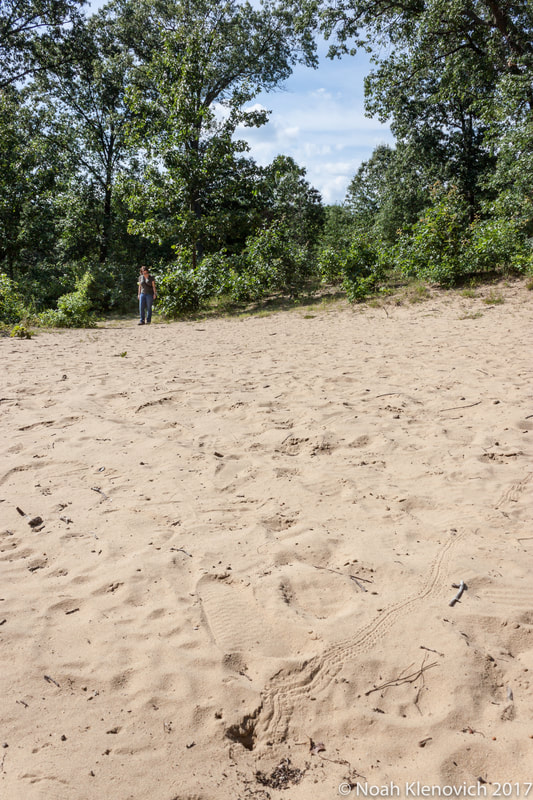|
The Oak Openings area has been called "One of the 200 'Last Great Places on Earth'" by the Nature Conservancy, and rightly so, this sandy region that is part of the Toledo Metroparks is a rare and unique ecosystem known as an Oak Savanna. Let's start with some Q & A then we'll get into the cool things we found... What is an Oak Savanna? An Oak Savanna is commonly defined as a plant community where trees are a part of the landscape but their density is so low as to allow grasses and prairie vegetation to dominate the community. Another way to think about that would be by gauging the tree canopy density - I know, that sounds complicated, but stick with me here - we'll pretend it's noon in midsummer, if you were in an oak savanna there would be less than 50% shadow coverage or half the ground would be in sunlight, if there was more than 50% shadow coverage you're in a woodland or forest. Why is it so rare? Early travelers in the Midwest would remark on how "park-like" these areas were, with the large trees and easy to traverse grasses. This made these areas easy to inhabit while settlers moved west and why many of these areas have disappeared. Why don't these areas become woodlands? The oak savannas of the midwest are closely linked (ecologically and topographically) to the native prairies of the area - these are the types of plants that grow well in these areas. However, as woodlands encroach on the savannas, and as leaf litter builds up, it is common practice to perform routine managed fires (when the midwestern savanna stretched from Texas to Canada, this would occur naturally through lightning strikes). Oak trees are equipped with unique fire-resistant qualities allowing the grasses and other trees and shrubs to be burnt down while the oaks remain fine. It's also been found that fire, while it will burn oak saplings to the ground, actually help the saplings grow deeper roots which will then allow the sapling to grow back stronger. Alright, now tell me about this particular savanna - Oak Openings. So, the Oak Openings (Toledo Metropark) takes its name from the surrounding oak openings region, which is 23 times larger than the park itself - that is huge as the park itself is about 5,000 acres!! The area is incredibly diverse - prickly-pear cactus, wild lupine, and sand cherry can be found on the hot sand dunes while just yards away there will be delicate orchids blooming in the low, wet swales. Back thousands of years during the Late Wisconsin Period the glaciers flattened and leveled the ground in the area all the while depositing clay till. This formed the basis for the "Great Black Swamp" south of the Maumee River. When the glacier melted back, it blocked the outlet for Lake Erie, so all the meltwater deposited sand into the shallow pro-glacial lakes. From Napoleon, OH to west of Detroit, Michigan it is known as the "sand belt". When the water receded, the sand was blown into dunes sitting on top of the impervious (non-draining) clay till - this is how the area can have such diversity so close together - the water flows through the sand leaving the sand dry but with the clay base the water flows to the adjacent poorly drained swales making water available to plants and animals in the Oak Openings. What did we see? When we arrived, I don't think either of us had any idea of just how big this park was - turns out there's over 50 miles of trails through a variety of different habitats - so we opted for the one that would work best for the amount of time we had - the Sand Dunes (red) trail. We started the journey through a cool coniferous forest that led us to the breath-taking openings. I still can't find the words to describe what it was like there, it was cool and covered but bright, you could see through the trees for what felt like miles, the ground, while covered, maintained the comforting safe visibility that I'm sure the settlers found to be ideal (no giant monsters hiding in those woods!). The covering - to my surprise - was mostly light and airy ferns (makes sense now that I know about the clay, sand, and water, and how they work together). The oaks in this area were huge! As we continued on, we came to the sand dunes where we may have lost the trail and may have wandered further than we should have but we came across the most interesting scene.
A very awesome discovery to be sure! From there we back-tracked until we found the trail again and wandered back through low wetlands, forested areas, and savanna. This is an area I'd like to spend more time, see it through the different seasons, watch as it comes back after a burn. As we left, we stopped by a different trail where during the Great Depression WPA workers planted stands of isolated pine and spruce. I highly recommend checking out this area to everyone whether interested in birding, flowers, geology, or just taking a nice stroll - this is the place!
0 Comments
Leave a Reply. |
AboutSince 2015 we have been exploring and sharing all the amazing things we’ve found in nature. AuthorEmily is an Ohio Certified Volunteer Naturalist who is most often found out in the woods. Archives
June 2024
Categories
All
|

 RSS Feed
RSS Feed